T1D isn’t a pleasant thing to have at any age. You’re getting poked and prodded all the time, there are about a million decisions to make, and everything just gets a little more complicated. But there’s something particularly unpleasant about navigating T1D when your baby or toddler is the one with the disease. Here are 20 things that parents of T1D babies and toddlers have to deal with that other people with T1D usually don’t.
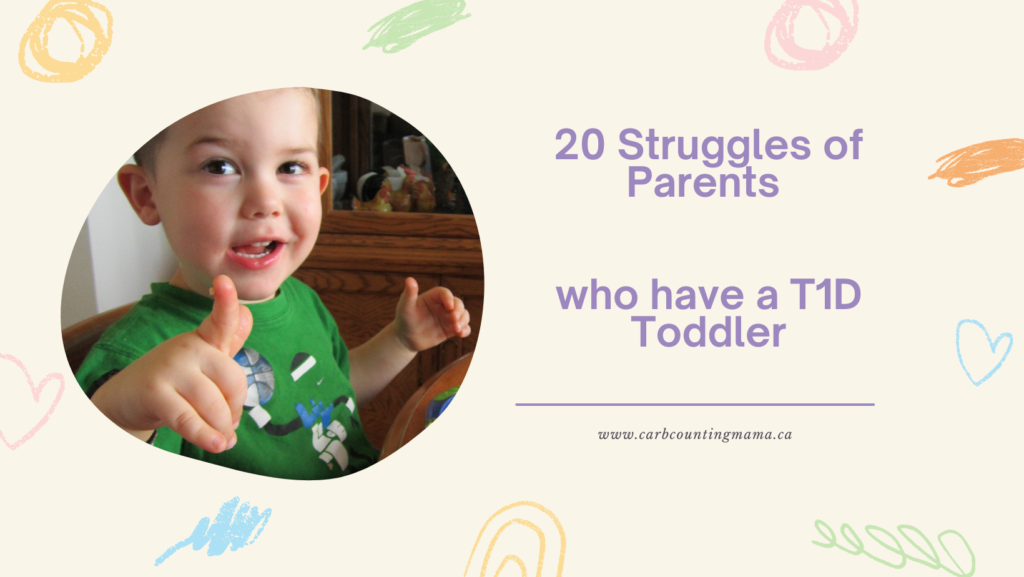
This post contains affiliate links
Toddlers are so little
Let’s start off with some of the problems that come from the size of our babies and toddlers. There are some things that are tricky to manage with our little ones that most other people won’t ever have to think about.
1. Not enough “real estate” for sites or injections
“The nurse told us to put 2 inches between pump sites. She said we should be getting 6 sites on each side of my child’s belly. Ummmm…do you know how tiny these kids are?”
When giving insulin, you need to “rotate” your injection sites to avoid a build-up of scar tissue. You’re also supposed to leave space between the sites. Realistically, how many spots does that allow for a baby or toddler?
The same goes for CGM and pump insertions and finger pokes. There are only so many places you can poke without reusing the same spots.

2. Tiny amounts of insulin
“The littlest bit of insulin caused major lows – even 0.05 units from the pump was too much a lot of the time.”
Many babies and toddlers need very very small amounts of insulin. But the smallest increment of insulin that you can give with insulin pens is half units. Some only give full units of insulin. Lots of parents of very young T1D children will “eyeball” quarter units when using syringes, but even that is too much insulin sometimes.
“We met a family who’s baby was 6 months old when diagnosed. They talked about giving 0.5 fast acting and then having to follow it up not long later with a syringe of jam due to it causing a low when the baby was in the 20s to start.”*
* “20s” is approximately 360 – 520 range in mg/dL
3. Pump tubing is way too long
“WHY have they not made insulin pump tubing in shorter lengths for babies and toddlers?”
As most people who have used a tubed insulin pump know, those things can be a bit of a drag sometimes. They stick out of your clothing, get caught on doorknobs, and some people even have pets that like to chew through the tubing at night.
But with a baby or toddler, the pump tubing is so long that it’s hard to find a place for it. That often results in tucking it in the only available spot… their diaper or pull-up. I’m sure you can imagine what happens when pump tubing is in a diaper.
Diapers, breastfeeding, and diabetes

Speaking of diapers…
Babies and toddlers can be a handful. T1D is a complicated, full-time job. Put them both together and many “normal” tasks become extremely complex.
4. Blowouts on recent or current device spots
“Oh gosh. A blowout on a recent device spot. The infection risk.”
For those who are not parents and may be unaware, a diaper blowout is when the child poops and it comes out of the diaper. Often, it goes either up their back and/or down their legs. It’s a mess and it’s awful to deal with when your child doesn’t have T1D.
But when they have diabetes, and the blowout is on a pump site or a recent site, well, that’s a whole new level of gross. Cleaning and changing the site is not a pleasant task. And since there’s what essentially equates to an open wound, there’s a higher risk of infection when this happens with a T1D kiddo.
5. Cotton balls in the diaper to check ketones
“trying to squeeze enough liquid out of a diaper to check for ketones”
I always advocate for the use of blood ketone meters to check for ketones. But not everyone has access to those and the test strips can be really expensive. The alternative is to use urine test strips.
With older kiddos, it’s not too difficult to get them to pee on a stick. But for your un-potty-trained baby or toddler, it can get a little messy.
Wringing out a diaper to get urine is not a great option. It’s gross and frankly, diapers are so absorbent that you’re unlikely to get any liquid anyway. Most parents of little ones use cotton balls instead. What a mess!
6. Carb counting breast milk
“We were told we’d have to stop breastfeeding. It was either that or figure out how to SWAG how much she was eating”
Carb counting in general is pretty complicated. But how do you do it when you can’t measure, or even see, what is being ingested? Yes, the child could still take their parent’s milk from a bottle. At least that way you can measure it.
Assuming that baby will even take a bottle, which honestly, not all of them will, that still presents a difficult situation. Not everyone is able to or wants to nurse their babies, but having that option taken away suddenly can be traumatic for babies and parents alike.
7. Potty training with an insulin pump
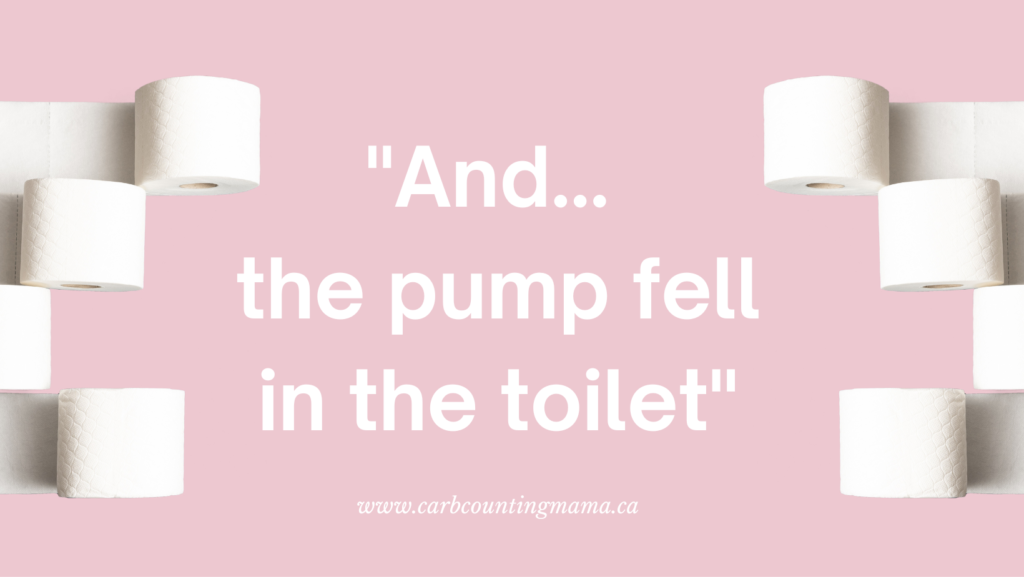
“And… the pump fell in the toilet”
Potty training can be tricky at the best of times. But when you have a T1D toddler, it’s a whole new level. If you’re using an insulin pump, site location can make or break your day.
Pod on the upper butt or thigh? Yeah, not anymore. Kiddo pulled down his pants too quickly and ripped it clean off.
Tubed pump? When it falls out of their spibelt or pocket into the toilet, you’re having a bad day.
Communication
The mixture of T1D being so complicated and babies and toddlers not having very good communication skills creates several issues as well.
8. Not being able to explain why you’re “hurting” them
“Having to chase and hold down your 2yr old toddler because she doesn’t understand the insulin shots keep her alive.”
As a parent of a T1D child, we know that our child requires insulin injections to stay alive. But how can you possibly explain that to a baby or toddler? All they know is that something painful is happening, whether that’s finger pokes, insulin injections, or device insertions, and their safe trusted adults are the ones who are causing that pain.
However, little kids do catch on quickly. They’ll see a kit come out and know that it means they’re going to get a poke of some kind. Have you ever tried to buckle a toddler into a car seat or stroller when they don’t want to be buckled in? Imagine that same toddler energy, but you need to give them an injection.
9. Ripping off devices
“Ripping off devices. Once it got uncomfortable it was all over.”
Diabetes devices are expensive. And they’re life-saving devices. They also have an adhesive that is sometimes itchy. Many people find them uncomfortable from time to time.
As adults, we can understand that it’s needed and work through the discomfort. Even older children can often do this. But guess what a baby or toddler will do when their site gets itchy? Or if they see it and it’s frustrating them in some way? Or if they get curious about what would happen if they pull at it?
They rip the device off. These devices cannot be reinserted. Once they’re off, a brand new one needs to be used. That means extra pokes and possibly lost insulin and money. And to top it off, if they were to rip off an insulin pump site during the night without the parents noticing, it could lead to a hospital visit for DKA.
10. They can’t tell you when they don’t feel well (high or low)
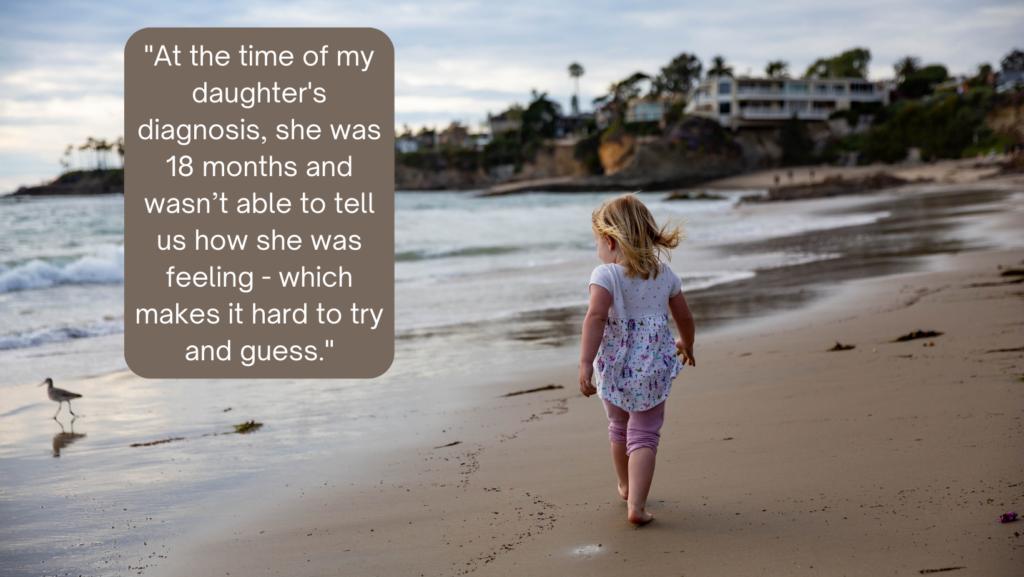
“At the time of my daughter’s diagnosis, she was 18 months and wasn’t able to tell us how she was feeling – which makes it hard to try and guess.”
Even adults with T1D sometimes confuse high or low feelings with feelings of hunger or tiredness. Babies and toddlers often don’t have the words, let alone the body awareness, to recognize and communicate how they’re feeling.
That means an urgent low blood glucose number could come seemingly out of nowhere. Or, they could be sitting at a high number for a long time without anyone knowing. But sometimes, if we’re very lucky, our babies and toddlers will have physical signs of highs or lows:
“I could tell if he was high or low from across a playground or room. His color, the way he’d stand or move, the look in his eyes…He was hypo unaware and couldn’t tell me that he was feeling “off” so I became fluent in his T1D high and low body language.”
But not everyone shows signs and not every parent or caregiver is aware of what to look for. Even if you are, the close calls stay with you for a long time after they’re out of the toddler stage:
“When the face and lips go pale my stomach still drops.”
11. Trusting other adults to care for your child
“Having to be everywhere and anywhere your child is at all times to keep him safe because he is fully dependent on you.”
Considering the first half of this list, it’s no big surprise that many parents of T1D toddlers don’t want to pass along this responsibility to someone else.
Finding a babysitter, daycare, or even having friends and relatives care for your T1D toddler can be stressful. Many people find ways to work around the entire situation. They work from home, or one parent quits their job. But, not everyone is able to do that.
So, you have to trust someone. And if you can find someone you trust, you then have to walk the tightrope of explaining T1D to them. They have to understand how serious and urgent T1D is, particularly lows, but you don’t want to scare them off in the process.
When your baby or toddler is unable to communicate much with you, it’s even more important to find caregivers who you trust and can communicate effectively with.
Food
Food is a big part of T1D. When you have a T1D toddler, you’re taking something that is already tricky for many parents (promoting a healthy relationship with food) and adding a bunch of extra stress and negative components to the mix.
12. Treating lows when your baby isn’t eating solid foods yet
“Being forced to eat solids when all you’ve ever known was breastmilk, formula, and a couple of scoops of pureed baby food.”
Many people know that babies can be diagnosed with T1D. Some have been diagnosed as young as a few days old. But when you take a moment to think about what that means, it’s a bit mind-blowing.
How do you treat lows for someone who has only ever consumed breastmilk or formula?
“Didn’t drink juice at the time so I’d have to give her smashed bananas! That was another tough thing finding things that she’d take for lows”
Bananas are a great source of sugar and this is a fantastic idea. Most pureed fruits are probably good options if your baby or toddler will take them.
But what if they won’t? And what about nap time or overnight when they’re sleeping?
“Sugar water oral syringes in the middle of the night to tackle lows”
Let’s just say that parents who have had to treat lows on such small babies and toddlers are a whole new level of superhero!
13. Food refusal and picky eating
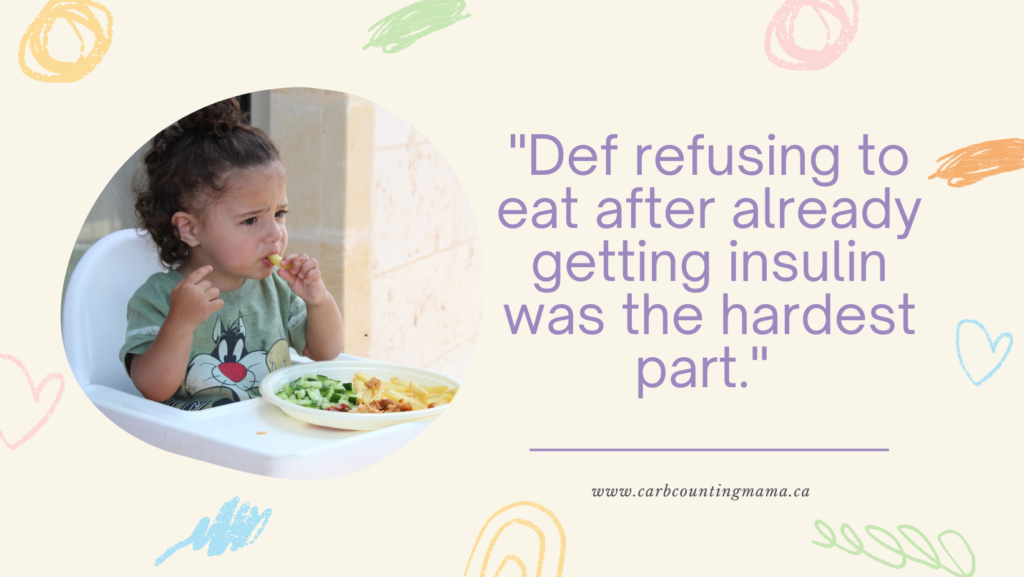
“Def refusing to eat after already getting insulin was the hardest part.”
Because insulin takes a bit of time to start working, it’s common practice to give the insulin dose before eating. With babies and toddlers, this can be a dangerous method. If you administer insulin and then they refuse to eat, their blood sugar level will go dangerously low.
“Bolusing for something the child asked for but when it’s put in front of them they say that’s not what I wanted or refused to eat”
With really picky eaters, it’s common to dose after they’re done eating. It is more likely to cause spikes in blood glucose, but it’s safer than having insulin with no food. Because when it comes to toddlers, sometimes they even refuse to eat things that they specifically asked for.
14. Associating food with pain
“He came to associate eating with injections and would just refuse food, hoping to avoid the injection.”
Pavlov’s theory doesn’t just apply to dogs and bells. People tend to make connections between things that happen at the same time. Babies and toddlers with T1D often notice that with food comes a poke or two.
This can result in food refusal. Not due to normal toddler pickiness, but because they’re trying to avoid the pain of a finger poke or shot by avoiding the food.
15. Rigid meal and snack schedules
“Trying to get a toddler to eat when they don’t want to.”
Especially right after diagnosis, many doctors want their patients to eat a certain amount of food at certain times. This can help them quickly figure out how much insulin the person needs.
The problem is, babies and toddlers don’t eat like that. Sometimes the amount of food that doctors want T1D patients to consume is simply too much for a young child. And limiting when and how much a child can have at snack time can cause unnecessary power struggles over food.
Toddler or T1D?
A really tricky part of dealing with a toddler who has T1D… well… some symptoms of T1D are very similar to normal toddler behaviors.
16. Nap time or low?
“Every time they fall asleep you wonder if it’s blood sugar related or if they’re just tired”
Since low blood sugar can cause people to lose consciousness, it’s a bit scary when your T1D toddler suddenly falls asleep at an unusual time. If they nap longer than usual or sleep in unexpectedly, that can cause parents to worry.
That’s something that is completely normal and happens frequently with babies and toddlers. Their sleep patterns change, T1D or not. But when you have a T1D toddler you are constantly asking yourself, is this T1D, or is it a normal sleep phase?
17. Typical toddler or T1D?
“Every tear… is he high? Is he low? Is he just a toddler?”
Toddlers are unpredictable. They get upset by things that we don’t expect and they act silly sometimes. But so do people with T1D when their blood sugar is high or low.
Are they acting silly just because it’s fun? Or is it because their blood glucose is low and they’re confused?
Did they suddenly get really hyper because they’re excited? Or is their blood sugar high and that’s how it physically manifests?
It really is difficult to tell the difference sometimes.

18. Tantrum or “T1D”?
“Every tantrum you didn’t know if she was high or low or just being a toddler until you pricked her finger”
Toddlers often experience big emotions. But when your toddler has T1D, sometimes those big emotions are triggered by changes in blood sugar levels. Being high and low doesn’t feel good, but they don’t know how to explain that, so sometimes, they tell us by crying or getting angry.
It could be that they just really really wanted the yellow cup instead of the green one. Or, it could be that their blood glucose level is going up or down and it’s causing discomfort in their little body.
Are you familiar with toddlers?
Last, but not least, there are some things that are very normal for toddlers that completely throw a wrench into managing T1D:
19. Frequent illnesses
“frequent illness which often landed her in the hospital”
When you’re dealing with T1D, any illness is serious. Even a common cold can wreak havoc on blood sugar levels. All illnesses bring with them the possibility of DKA and a hospital visit.
And if you know any toddlers, you might have noticed that they’re kind of gross. They lick and touch things that they shouldn’t.
Places like daycare and preschool are basically germ factories. Keeping your T1D toddler healthy and out of the hospital can become a challenging task.
20. Waking up for T1D AND baby feeding/changing
“The hardest part at the beginning was waking up for lows and highs when I was already waking up to deal with baby things.”
After blood glucose management, sleep deprivation is one of the hardest aspects of T1D. Since managing T1D is a 24/7 job, many people are up multiple times a night dealing with blood sugar numbers.
Add a baby into the mix and now you’re awake more than you’re asleep during the night. Night feedings, diaper changing, and getting up to check blood glucose can take a toll.
21. Unexpected energy/ activity
“The ability to go hog wild any time anywhere, which means activity and exercise can almost never be planned. “
Have I mentioned that toddlers are unpredictable?
Well, here’s something I haven’t mentioned yet. Activity level plays a role in blood sugar numbers. The more active a person with T1D is, the more insulin sensitive they become. That means, the insulin they have in their body works better than intended.
And that can cause low blood sugar numbers.
It’s one thing when you have a planned activity like sports or a hike. But with toddlers, a random game of chase or tickle monster can turn into a low blood sugar number.
22. Sitting still to recover from a low
“He was also a very busy 2.5yo, so getting him to sit quietly during a low was challenging”
Since activity can result in low blood sugar, it’s important to sit and wait while you’re treating the low. That generally takes at least 10-15 minutes, sometimes even longer. To a toddler, that can feel like an eternity.
“Combine the inability to sit and eat with unexpected bursts of energy…you feel like a walking ball of stress.”
They often don’t want to sit still while waiting for their blood sugar to come back up. But if they keep running around, the low number is likely to get worse.
The problem is, they don’t understand that. The dangers of low blood glucose numbers are an abstract concept for a toddler. They just want to keep playing and running.
“Having to make your child stop playing to treat blood sugars and sometimes never allowing him to return to play because blood sugars were stubborn and just would not come back up.”
Sometimes, that means they need to stop playing completely. While we as parents understand why this is happening, it’s very difficult to explain it to a toddler who feels like they need to run.
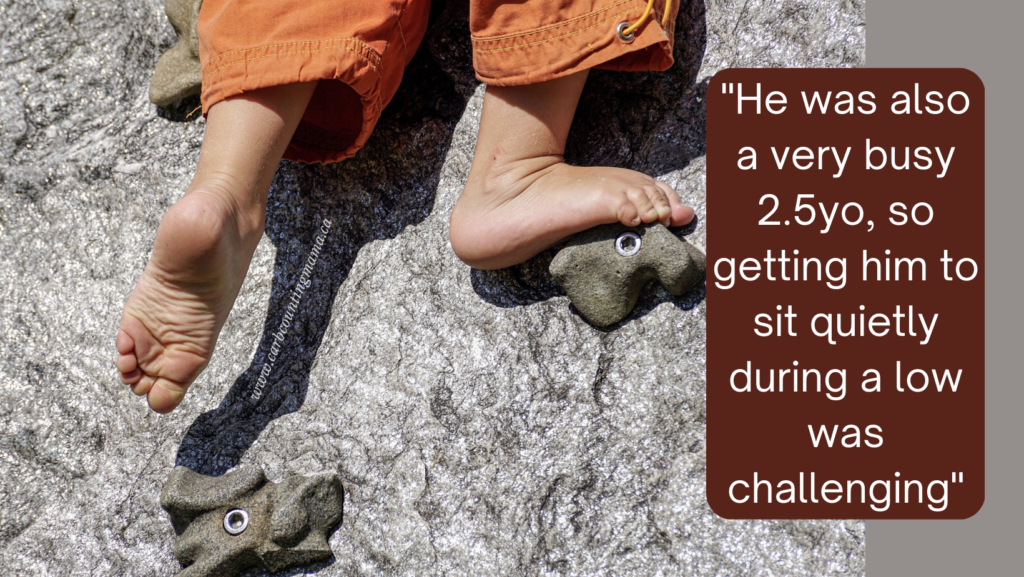
T1D can be difficult at any age
It’s a frustrating, stressful, complicated disease.
But with a T1D toddler or baby comes a whole world of challenges that no one expects.
If you’re in this stage with your T1D baby or toddler, know that you will get through it. Many of the things on this list will fade away. New challenges will come up, and you’ll deal with those too.
It doesn’t exactly get easier, but you do get a lot better at it.
If you know someone who is in this stage, remember to give them grace. It’s very difficult to navigate having a toddler with T1D. Parents of T1D toddlers might need to decline invitations and stay with their children.
They’re not avoiding or ghosting you. They’re simply doing everything they need to do to keep their child alive.
Do you have a T1D toddler or baby? What’s missing from this list of T1D toddler struggles? Let me know in the comments!
For more tips and stories about T1D, join the Carb Counting Mama email list, and make sure to head over to the Carb Counting Mama Facebook page and “like” it.
Our little guy was diagnosed at 2 yrs 4 months and he is now 4yrs 3 months old. Reading this list of struggles unique to toddlers/babies with T1D was a very emotional thing for me to do. It brought back so many memories from the past two years. Before diagnosis, our son had never had candy nor juice, and had had very limited processed food. That all changeed in the blink of an eye. The cotton balls in his diaper, bolusing before meals and then stressing out because he didn’t want to eat or because most of his food ended up on him or the floor, finding enough ‘real estate’, not understanding why mommy and daddy were ‘hurting’ him, and him not being able to communicate how he was feeling where some of the really though moments.